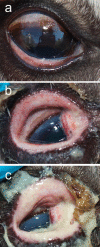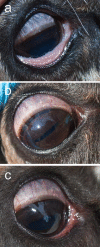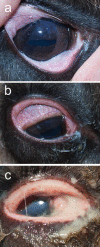Cervid herpesvirus 2 and not Moraxella bovoculi caused keratoconjunctivitis in experimentally inoculated semi-domesticated Eurasian tundra reindeer
- PMID: 28438213
- PMCID: PMC5404682
- DOI: 10.1186/s13028-017-0291-2
Cervid herpesvirus 2 and not Moraxella bovoculi caused keratoconjunctivitis in experimentally inoculated semi-domesticated Eurasian tundra reindeer
Abstract
Background: Infectious keratoconjunctivitis (IKC) is a transmissible disease in semi-domesticated Eurasian reindeer (Rangifer tarandus tarandus). It is regarded as multifactorial and a single causative pathogen has not yet been identified. From clinical outbreaks we have previously identified Cervid herpesvirus 2 (CvHV2) and Moraxella bovoculi as candidates for experimental investigations. Eighteen reindeer were inoculated in the right eye with CvHV2 (n = 5), M. bovoculi (n = 5), CvHV2 and M. bovoculi (n = 5) or sterile saline water (n = 3; controls).
Results: All animals inoculated with CvHv2, alone or in combination with M. bovoculi, showed raised body temperature, increased lacrimation, conjunctivitis, excretion of pus and periorbital oedema; clinical signs that increased in severity from day 2 post inoculation (p.i.) and throughout the experiment, until euthanasia 5-7 days p.i. Examination after euthanasia revealed corneal oedema, and three animals displayed a corneal ulcer. CvHV2 could be identified in swab samples from both the inoculated eye and the control eye from most animals and time points, indicating a viral spread from the inoculation site.
Conclusions: This study showed that CvHV2 alone and in combination with M. bovoculi was able to cause the characteristic clinical signs of IKC in reindeer, whereas inoculation of M. bovoculi alone, originally isolated from a reindeer with IKC, did not produce clinical signs. Previous studies have suggested that herding procedures, animal stress and subsequent reactivation of latent CvHV2 infection in older animals is a plausible mechanism for IKC outbreaks among reindeer calves and young animals in reindeer herds. However, further studies are needed to fully understand the infection biology and epidemiology associated with IKC in reindeer.
Keywords: Alphaherpesvirus; Eye disease; IKC; Moraxella; Ophthalmology; Reindeer; Wildlife.
Figures




Similar articles
-
Infectious keratoconjunctivitis in semi-domesticated Eurasian tundra reindeer (Rangifer tarandus tarandus): microbiological study of clinically affected and unaffected animals with special reference to cervid herpesvirus 2.BMC Vet Res. 2018 Jan 16;14(1):15. doi: 10.1186/s12917-018-1338-y. BMC Vet Res. 2018. PMID: 29338721 Free PMC article.
-
Ocular Histopathological Findings in Semi-Domesticated Eurasian Tundra Reindeer (Rangifer tarandus tarandus) with Infectious Keratoconjunctivitis after Experimental Inoculation with Cervid Herpesvirus 2.Viruses. 2020 Sep 9;12(9):1007. doi: 10.3390/v12091007. Viruses. 2020. PMID: 32917018 Free PMC article.
-
Cervid herpesvirus 2, the primary agent in an outbreak of infectious keratoconjunctivitis in semidomesticated reindeer.J Clin Microbiol. 2009 Nov;47(11):3707-13. doi: 10.1128/JCM.01198-09. Epub 2009 Sep 2. J Clin Microbiol. 2009. PMID: 19726598 Free PMC article.
-
Cervid herpesvirus 2 infection in reindeer: a review.Vet Microbiol. 2010 Jun 16;143(1):70-80. doi: 10.1016/j.vetmic.2010.02.015. Epub 2010 Feb 11. Vet Microbiol. 2010. PMID: 20207086 Review.
-
Zoonotic infections in semi-domesticated eurasian tundra reindeer (Rangifer tarandus tarandus) in Fennoscandia - a review.One Health Outlook. 2025 Apr 8;7(1):18. doi: 10.1186/s42522-025-00140-0. One Health Outlook. 2025. PMID: 40197305 Free PMC article. Review.
Cited by
-
Infectious keratoconjunctivitis in semi-domesticated Eurasian tundra reindeer (Rangifer tarandus tarandus): microbiological study of clinically affected and unaffected animals with special reference to cervid herpesvirus 2.BMC Vet Res. 2018 Jan 16;14(1):15. doi: 10.1186/s12917-018-1338-y. BMC Vet Res. 2018. PMID: 29338721 Free PMC article.
-
New Paradigms for the Study of Ocular Alphaherpesvirus Infections: Insights into the Use of Non-Traditional Host Model Systems.Viruses. 2017 Nov 18;9(11):349. doi: 10.3390/v9110349. Viruses. 2017. PMID: 29156583 Free PMC article. Review.
-
A Screening for Virus Infections among Wild Eurasian Tundra Reindeer (Rangifer tarandus tarandus) in Iceland, 2017-2019.Viruses. 2023 Jan 23;15(2):317. doi: 10.3390/v15020317. Viruses. 2023. PMID: 36851530 Free PMC article.
-
Chlamydia pecorum Associated With an Outbreak of Infectious Keratoconjunctivitis in Semi-domesticated Reindeer in Sweden.Front Vet Sci. 2019 Feb 5;6:14. doi: 10.3389/fvets.2019.00014. eCollection 2019. Front Vet Sci. 2019. PMID: 30805351 Free PMC article.
-
A serological screening for potential viral pathogens among semi-domesticated Eurasian tundra reindeer (Rangifer tarandus tarandus) in Finland.Acta Vet Scand. 2023 Feb 22;65(1):8. doi: 10.1186/s13028-023-00671-4. Acta Vet Scand. 2023. PMID: 36814283 Free PMC article.
References
-
- Bergman A. Contagious keratitis in reindeer. Scand Vet J. 1912;2:145–177.
-
- Rehbinder C, Nilsson A. An outbreak of kerato-conjunctivitis among corralled, supplementary fed, semi-domesticated reindeer calves. Rangifer. 1995;15:9–14. doi: 10.7557/2.15.1.1151. - DOI
-
- Oksanen A. Keratoconjunctivitis in a corralled reindeer. Proceedings of the seventh Nordic Workshop on Reindeer Research. Rangifer Report. 1993;1:50.
MeSH terms
LinkOut - more resources
Full Text Sources
Other Literature Sources

